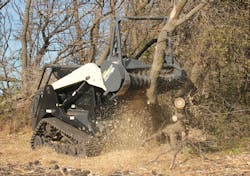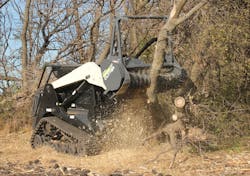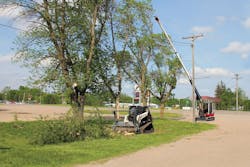WEB EXCLUSIVE: Go small or go home
We live in an age where bigger is better—bigger burgers, bigger flat-screen TVs and, in the world of clearing vegetation, bigger equipment.
A large-scale mechanical tree trimmer with a 75-ft boom can tear into towering pines, and a dedicated mulching machine will make mincemeat of the thickest buck brush.
A skid-steer mulcher chews through overgrowth in close quarters.
But aside from rural areas offering ample space to maneuver, these behemoths can be a headache to handle and transport. Good luck maintaining right-of-ways near urban sprawl. In such cases, bigger is definitely not better, but instead a hindrance to operators, residents, motorists and utility company vegetation-management professionals whose operations bear, in many cases, a direct relationship with those of state and local construction contractors.
Increasingly, the argument with clearing equipment is to go small—compact—not big. And through technological advancements, increased power and affordability, such compact equipment options can expand versatility.
Money in the bank
More and more, professionals are discovering that, compared with larger dedicated machines, equipment such as horizontal drum mulcher attachments and compact mechanical trimmers increase efficiency and achieve a faster return on investment. When the economy faltered several years ago, it forced professional arborists to increase output while minimizing cost. Although the economic environment today has improved, many companies haven’t lost that conservative mindset, that need to do more work with fewer resources.
Efficiency remains key to the success of any business, so when purchasing equipment it is important to think about versatility and how soon that equipment will pay for itself. A person can save money by purchasing a mulching attachment for an existing tractor, rather than buying a dedicated mulching machine. In the same breath, selecting from reputable manufacturers with a solid customer service program also can ensure the success of a new purchase. That kind of peace of mind is worth plenty to a contractor on a tight budget.
Technological advancements
What may not be as apparent are the improvements in technology and efficiency compared with earlier models. What once was the job of large-scale trimmers and mulching machines can now largely be completed using a skid steer, compact excavator or even small tractor—equipment already utilized in day-to-day operations.
Compact mulching equipment has improved significantly over the years, thanks in part to the advancements in the machines to which they attach. Skid steers now offer much better hydraulic flow and pressure than their predecessors from even a decade ago. This increased hydraulic output allows for higher-performance attachments capable of tackling tough jobs that once were completed by bigger equipment.
Mulcher improvements
Horizontal drum mulchers have come a long way, too. With hydraulics that automatically adjust to loads and high-rpm rotary heads laced with a gamut of cutter options, they are designed to optimize vegetative clearing, be it tall grasses, brush or small-to medium-sized trees.
Aside from their cutting parts, modern mulchers are leaps and bounds ahead of yesterday’s less advanced models. They can be attached to a number of compact equipment options, from skid steers to tractors, and offer clearing results similar to larger mulchers, but with increased maneuverability and transportability between jobsites. Instead of a dedicated semi truck, a pickup and trailer easily transports these small, highly versatile machines.
Trim a little off the top
There used to be only a couple ways to trim trees along utility line right-of-ways: using a bucket truck or physically climbing to cut limbs by hand, or operating a large-scale mechanical trimmer. Although effective, neither option is ideal in all cases, the former being more dangerous and the latter being expensive and unwieldy. However, today there are smaller trimmer options that both increase safety and greatly improve close-quarter maneuverability.
Mechanical trimmers mounted to the chassis of compact excavators utilize a nonconductive telescoping boom that extends up to 53 ft. With a saw blade at the end, these machines do work similar to hand-trimming out of a bucket truck, but in a fraction of the time. Plus, once the branches are on the ground, a skid steer mulching head can be used to clean up, which effectively provides a hyper-efficient one-two punch.
A telescoping boom allows a cutting tool to negotiate a series of power lines, while a skid steer handles the dropped-down material.
Another advantage of a compact mechanical trimmer is the small footprint. There’s no way a large-scale mechanical trimmer could work inside the tight confines of an urban environment where houses, busy streets and yards are packed together. Although a compact trimmer doesn’t have the reach of bigger implements, it can handle a majority of the work found in such settings. Those few areas that can’t be reached can still be trimmed the traditional way.
And when the job is done, no special transportation equipment is needed. Often a smaller crew cab tractor-trailer rig can condense trips to the jobsite. This setup cuts down on transportation hassles and greatly increases the efficiency of moving equipment and personnel.
Do-it-all convenience
Right-of-way clearing is a specialized field. While buying large, dedicated cutting and mulching machines may be out of reach for smaller companies, owning attachments for compact equipment they already possess is far more realistic.
An added benefit is that these unique resources help set companies apart, a key component when bidding for work. Utility companies, for example, looking for right-of-way line-clearing contractors might see the convenience of an outfit equipped with compact equipment as an effective way to service tight jobsites and residential areas in a way less intrusive to homeowners.
Although compact equipment may not be able to handle every clearing or cutting job, it can still do a lot more, and a lot more quickly, than many conventional methods. Adding mulcher attachments and compact mechanical trimmers to your fleet will expand versatility, improve production and increase safety. That adds up to more jobs in less time—a formula that equals money in the bank. R&B


